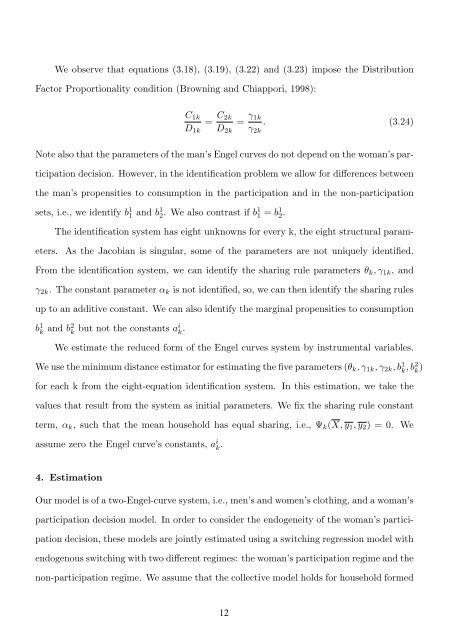THE SPANISH SHARING RULE* Bernarda Zamora - Ivie
Create successful ePaper yourself
Turn your PDF publications into a flip-book with our unique Google optimized e-Paper software.
We observe that equations (3.18), (3.19), (3.22) and (3.23) impose the Distribution<br />
Factor Proportionality condition (Browning and Chiappori, 1998):<br />
C 1k<br />
D 1k<br />
= C 2k<br />
D 2k<br />
= γ 1k<br />
γ 2k<br />
. (3.24)<br />
Note also that the parameters of the man’s Engel curves do not depend on the woman’s participation<br />
decision. However, in the identification problem we allow for differences between<br />
the man’s propensities to consumption in the participation and in the non-participation<br />
sets, i.e., we identify b 1 1 and b 1 2. We also contrast if b 1 1 = b 1 2.<br />
The identification system has eight unknowns for every k, the eight structural parameters.<br />
As the Jacobian is singular, some of the parameters are not uniquely identified.<br />
From the identification system, we can identify the sharing rule parameters θ k , γ 1k , and<br />
γ 2k . The constant parameter α k is not identified, so, we can then identify the sharing rules<br />
up to an additive constant. We can also identify the marginal propensities to consumption<br />
b 1 k and b2 k but not the constants ai k .<br />
We estimate the reduced form of the Engel curves system by instrumental variables.<br />
We use the minimum distance estimator for estimating the five parameters (θ k , γ 1k , γ 2k , b 1 k , b2 k )<br />
for each k from the eight-equation identification system. In this estimation, we take the<br />
values that result from the system as initial parameters. We fix the sharing rule constant<br />
term, α k , such that the mean household has equal sharing, i.e., Ψ k (X, y 1 , y 2 ) = 0. We<br />
assume zero the Engel curve’s constants, a i k .<br />
4. Estimation<br />
Our model is of a two-Engel-curve system, i.e., men’s and women’s clothing, and a woman’s<br />
participation decision model. In order to consider the endogeneity of the woman’s participation<br />
decision, these models are jointly estimated using a switching regression model with<br />
endogenous switching with two different regimes: the woman’s participation regime and the<br />
non-participation regime. We assume that the collective model holds for household formed

















